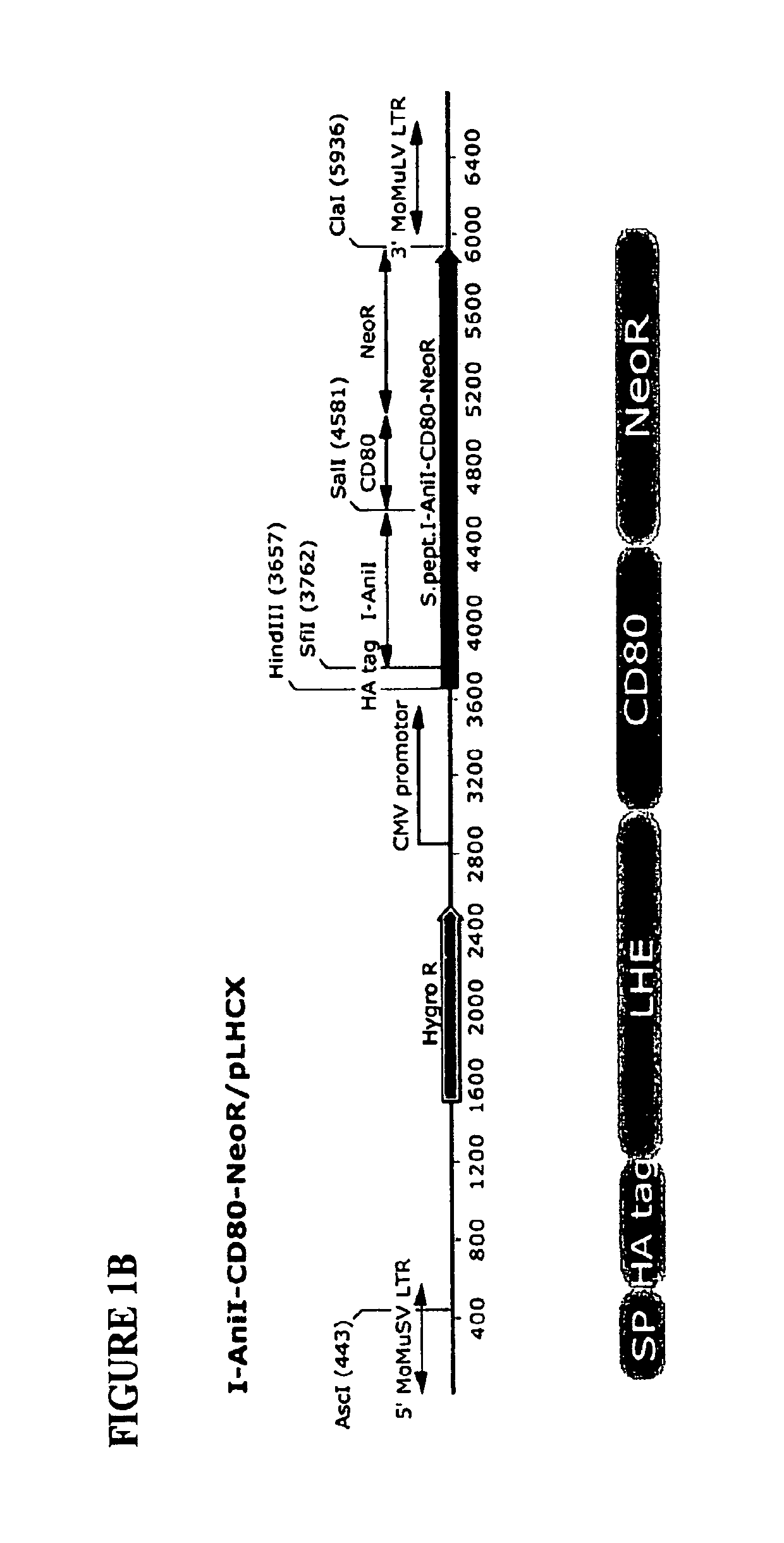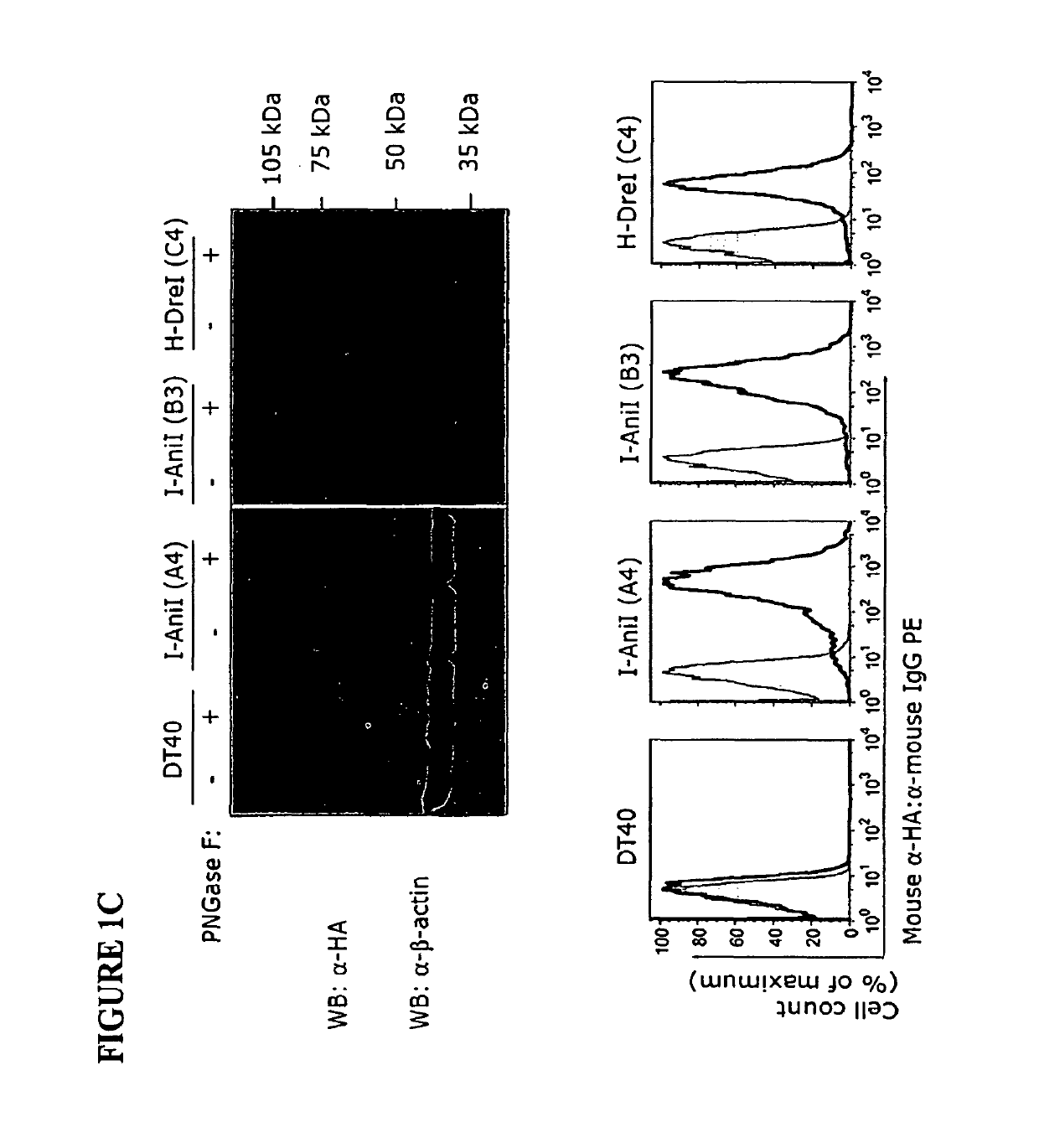Compositions and methods comprising the use of cell surface displayed homing endonucleases
a cell surface and endonuclease technology, applied in the field of site-specific dna cutting enzymes, can solve the problems of zfn chimeras, more total coding sequences, and efforts to increase or alter the specificity of type ii restriction endonucleases, but are generally unsuccessful
- Summary
- Abstract
- Description
- Claims
- Application Information
AI Technical Summary
Benefits of technology
Problems solved by technology
Method used
Image
Examples
example 1
The Following Methods were Used in the Working Examples Herein
Methods:
[0156]Plasmid Construction and Generation of Stable LHE Expressing DT40 Clones.
[0157]Vectors containing cDNA for both LHEs (I-AniI and H-DreI) were PCR amplified using following primers: I-AniI For SfiI (SEQ ID NO:1) and I-AniI Rev SalI (SEQ ID NO:2); H-DreI For SfiI (SEQ ID NO:3) and H-DreI Rev SalI (SEQ ID NO:4) and cloned into the pLHCX-phOx expression vector (Chou, et al., Biotechnol Bioeng, 65:160-169, 1999; Liao, et al., Biotechnol Bioeng, 73:313-323, 2001) by SfiI and SalI digestion to replace phOx coding sequence. To place the NeoR gene in frame in the I-AniI construct, the NeoR cDNA including the HSV polyA sequence was amplified using CD80-NeoR For (SEQ ID NO:5) and NeoR Rev ClaI (SEQ ID NO:6), while the existing I-AniI-CD80 expression construct (including the 5′ signal peptide and HA epitope) was amplified by primers SP For Hind3 (SEQ ID NO:7) and CD80-NeoR Rev (SEQ ID NO:8). The entire fusion molecule w...
example 2
Novel Expression of Homing Endonucleases on the Plasma Membrane Surface was Achieved
[0171]Example Overview.
[0172]LHEs are normally expressed in the cytosol and targeted to DNA-containing organelles posttranslationally. According to particular aspects of the present invention, cell surface display is achieved by cotranslational targeting to the secretory pathway and fusion to an appropriate transmembrane domain. Strategies of this sort have been previously used to support surface display of antibody fragments (e.g., Chou, et al., Biotechnol Bioeng, 65:160-169, 1999; and Liao, et al., Biotechnol Bioeng, 73:313-323, 2001), but prior to the present inventive aspects, DNA target site binding and cleavage activities of homing endonucleases (HE) were only known to occur in the context of free-standing enzymes in solution and / or intracellularly.
[0173]Methods.
[0174]For this Example, LAGILDADG homing endonuclease (LHE) genes were inserted between the coding sequences of the N-terminal murine ...
example 3
Surface Expressed LHEs were Efficiently Labeled with Fluorescently Conjugated dsOligos and Detected by Flow Cytometry
[0181]In this Example, the ability of the inventive cell surface displayed LHEs to bind annealed oligonucleotides representing the respective natural target specificities was confirmed using flow cytometry.
[0182]Methods.
[0183]HEs are enzymatically active in the presence of Mg2+ ions, which are present in the active site (Chevalier, et al., Nat Struct Biol, 8:312-316, 2001). When Mg2+ ions are replaced with Ca2+ ions, LHEs retain their DNA binding properties, while the cleavage of target DNA sequence is abolished (Chevalier, et al., Nat Struct Biol, 8:312-316, 2001; Chevalier, et al., Biochemistry, 43:14015-14026, 2004). While this metal ion specificity was known in the art for free-standing or intracellular enzymes, applicants conceived that this may also be true for cell surface displayed HEs and LHEs. Accordingly, a buffer containing 10 mM Ca2+ was used for cell-sur...
PUM
| Property | Measurement | Unit |
|---|---|---|
| molecular mass | aaaaa | aaaaa |
| volume | aaaaa | aaaaa |
| pH | aaaaa | aaaaa |
Abstract
Description
Claims
Application Information
 Login to View More
Login to View More - R&D
- Intellectual Property
- Life Sciences
- Materials
- Tech Scout
- Unparalleled Data Quality
- Higher Quality Content
- 60% Fewer Hallucinations
Browse by: Latest US Patents, China's latest patents, Technical Efficacy Thesaurus, Application Domain, Technology Topic, Popular Technical Reports.
© 2025 PatSnap. All rights reserved.Legal|Privacy policy|Modern Slavery Act Transparency Statement|Sitemap|About US| Contact US: help@patsnap.com



